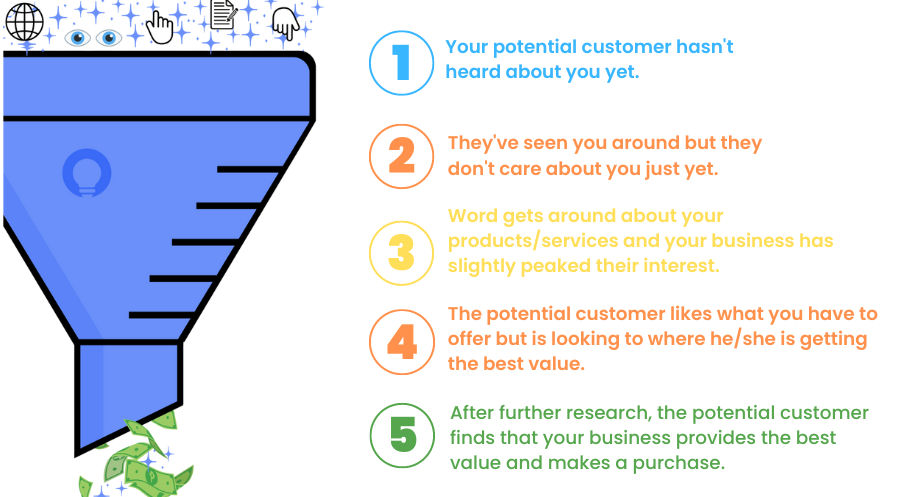Mastering Keyword Intent

Nick Czerwinski
PPC & Local SEO Specialist
Search intent, also known as user intent, refers to the reason or motivation behind a user’s search query. Understanding search intent is critical for advertisers as it helps them to target their ads more effectively and achieve better results. By aligning the content of their ads with the user’s search intent, advertisers can increase the relevance of their ads and improve the likelihood of users clicking on their ads.
In Google Ads campaigns, search intent is crucial in selecting keywords and crafting ad copy. Advertisers must choose the right keywords that reflect the search intent of their target audience. Otherwise, their ads may appear in front of users who are not interested in their products or services, resulting in wasted ad spend and lower conversion rates.
There are four main types of search intent that advertisers need to consider when creating Google Ads campaigns: informational, navigational, commercial, and transactional.
Informational Intent in Keyword Selection
Informational intent is when a user searches for information about a specific topic, product, or service. These users may be looking for reviews, comparisons, or recommendations. For example, a user searching for “best coffee makers” or “how to lose weight” has an informational intent.
Advertisers can use keywords that reflect the user’s search query to target users withinformational intent, such as “best coffee makers” or “how to lose weight.” Advertisers can also create ad copy that provides relevant and helpful information to the user.
Exploring Navigational Intent
Navigational intent is when a user searches for a specific website or web page. These users know precisely what they are looking for and are trying to navigate to a particular destination. For example, a user searching for “Facebook login page” or “Amazon Prime Video” has a navigational intent.
Advertisers can use branded keywords to target users with navigational intent, such as the name of their company or product. Advertisers can create ad copy with a clear call-to-action (CTA) to encourage users to click on their ad and navigate to their website.
Utilizing Commercial Intent for Google Ads Keyword Strategy
Commercial intent is when a user searches for a product or service to make a purchase. These users are actively looking for a solution to their problems. They are open to purchasing a product or service that meets their needs. For example, a user searching for “buy Nike shoes” or “best budget laptops” has a commercial intent.
To target users with commercial intent, advertisers can use keywords that reflect the user’s search query and include commercial terms such as “buy,” “purchase,” or “order.” Advertisers can also create ad copy containing relevant product or service information and a clear CTA to encourage users to purchase.
Transactional Intent in Google Ads Keyword Optimization
Transactional intent is when a user searches for a specific product or service with the intention of making a transaction. These users have already decided to purchase and are looking for the best deal or the most convenient option. For example, a user searching for “iPhone 14 for sale” or “cheap flights to New York” has a transactional intent.
To target users with transactional intent, advertisers can use keywords that include transactional terms such as “for sale,” “discount,” or “cheap.” Advertisers can also create ad copy with pricing information and a clear CTA to encourage the user to complete the transaction.
In addition to selecting the right keywords, advertisers can also use negative keywords to exclude irrelevant traffic from their campaigns. Negative keywords are words or phrases that are not relevant to the advertiser’s products or services and can help to prevent their ad campaigns waste money on irrelevant and low intent clicks.
Honestly, I consider him part of my Team as well, he really cares about our success. As we grow, he will grow with us. I’m excited about the journey and future with Mike and his Team at Metalogic! If you’re looking at Internet Marketing for your business, simply put he’s the best!

Chris Chustz
Owner, Family First Mortgage
Advantages of Considering Search Intent in Google Ads Keyword Selection
Better Targeting: By understanding the user’s search intent, you can select keywords more likely to target users interested in your product or service. This means that your ads will be shown to users who are likelier to take the desired action, resulting in higher click-through rates, conversion rates, and, ultimately, a better return on investment.
Improved Relevance: Using keywords relevant to the user’s search query can help improve your ads’ relevance. This means that your ads will be more likely to resonate with the user and address their specific needs or pain points. By doing so, you can improve the overall effectiveness of your campaigns and increase the likelihood of conversion.
Reduced Wasted Ad Spend: By using negative keywords to filter out irrelevant traffic, you can reduce wasted ad spending on users who are not likely to take the desired action. This means your ad budget will be spent more efficiently, resulting in a better return on investment.
Increased Quality Score: Google uses quality score to determine where your ads are shown and how much you pay per click. You can improve your ad relevance and quality score by using keywords that align with the user’s search intent and negative keywords to filter out irrelevant traffic. This can lead to higher ad rankings and lower cost per click.
Competitive Advantage: Using search intent to select your Google Ads keywords can give you a competitive advantage over other advertisers not considering search intent. This means that your ads will be more targeted, relevant, and practical, resulting in a higher return on investment compared to your competitors.
Using search intent when selecting your Google Ads keywords can lead to better targeting, improved relevance, reduced wasted ad spend, increased quality score, and competitive advantage. By understanding the different types of search intent and selecting relevant and negative keywords, you can create highly targeted campaigns that deliver the right message to the right audience.
Impact of Search Intent on Google Ads Keyword Choices
Search intent is a critical factor in selecting keywords for Google Ads campaigns. Choosing the right keywords that reflect the user’s search intent can help advertisers to reach the right audience and increase the relevance of their ads. On the other hand, using the wrong keywords can result in irrelevant traffic and wasted ad spending.
To select keywords that align with the user’s search intent, advertisers must understand the different types of search intent and the keywords that reflect each type. For example, when targeting users with informational intent, advertisers should use keywords that reflect the user’s search query and provide relevant and valuable information. On the other hand, when targeting users with commercial intent, advertisers should use keywords that include commercial terms such as “buy,” “purchase,” or “order” and provide product or service information.
Using keyword research tools can help advertisers identify the keywords that align with the user’s search intent. These tools can provide insights into the search volume, the competition level of different keywords, and suggestions for related keywords. Advertisers should also monitor their campaigns regularly and adjust their keyword selection based on the performance of their ads.
Negative keywords are also essential for advertisers to exclude irrelevant traffic from their campaigns. By identifying keywords that are not relevant to their products or services and adding them as negative keywords, advertisers can prevent their ads from appearing in front of users who are not interested in their offerings. For example, if an advertiser sells smartphones, they may want to exclude keywords related to tablets or laptops to avoid irrelevant traffic.
Understanding search intent is critical for selecting keywords in Google Ads campaigns. Advertisers must choose the keywords that reflect the user’s search intent and use negative keywords to exclude irrelevant traffic from their campaigns. By aligning their keyword selection with the user’s search intent, advertisers can increase the relevance of their ads, improve the click-through rate (CTR), and achieve better results.

Custom Marketing Plans Starting at $500 / month
Understanding the Role of Negative Keywords for Addressing Search Intent
How Negative Keywords Work
Negative keywords are used in Google Ads campaigns to exclude ads from showing up for irrelevant search queries. When a negative keyword is added to a campaign, it tells Google not to show the ad when a user searches for that particular term.
Importance of Negative Keywords for Search Intent
Negative keywords are crucial for addressing search intent because they help advertisers to filter out irrelevant traffic. By excluding search terms that don’t align with the user’s search intent, advertisers can ensure that their ads are only shown to users more likely to take the desired action.
Identifying Negative Keywords
To identify negative keywords, it’s essential to understand the different types of search intent and the keywords that are commonly associated with them. For example, if an advertiser is targeting users with a commercial intent, they may want to exclude search terms that indicate an informational intent, such as “how to” or “what is.”
Keyword Match Types
When adding negative keywords to a Google Ads campaign, choosing the appropriate keyword match type is essential. The different match types include broad, phrase, and exact match. Broad match negative keywords will exclude any search queries that contain the keyword. In contrast, phrase match will exclude search queries with the keyword in the same order as it was entered, and exact match will only exclude the precise keyword.
Monitoring and Updating Negative Keywords
Once negative keywords have been added to a campaign, monitoring the performance and updating the list regularly is essential. This will ensure that any new search terms irrelevant to the campaign are excluded and that the campaign continues to target the right audience.
Examples of Negative Keywords
To illustrate how negative keywords can be used to address search intent, here are some examples:
A company that sells luxury handbags may want to exclude search terms like “cheap handbags” or “discount handbags,” as these indicate a price-sensitive audience that may not be interested in their products.
An online education platform offering paid courses may want to exclude search terms like “free courses” or “YouTube tutorials,” as these indicate an audience looking for free resources rather than paid courses.
A real estate agency specializing in luxury properties may want to exclude search terms like “affordable homes” or “low-income housing,” as these indicate an audience not likely to be interested in their high-end properties.
By using negative keywords to address search intent, advertisers can improve their Google Ads campaigns’ relevance and effectiveness while minimizing wasted ad spending on irrelevant traffic.
Practices for Leveraging Search Intent and Negative Keywords in Google Ads
Conduct Thorough Keyword Research
To effectively address search intent with Google Ads, it’s essential to conduct thorough keyword research. This includes identifying the different types of search intent and the keywords commonly associated with each class. Keyword research tools like Google Keyword Planner, SEMrush, or Ahrefs can help you to identify relevant keywords and search volumes.
Use Relevant Match Types
When selecting keywords and negative keywords, it’s essential to use the appropriate match types. Broad match is the default setting in Google Ads but can result in irrelevant traffic. Using phrase or exact matches can help ensure that your ads are only shown to likelier users to take the desired action.
Monitor Performance Regularly
To ensure that your Google Ads campaigns target the right audience and address search intent effectively, monitoring their performance regularly is essential. This includes tracking critical metrics like click-through rates (CTR), conversion rates, and cost per conversion. Use this data to optimize your campaigns and adjust your keyword and negative lists.
Continuously Update Negative Keywords
As mentioned earlier, negative keywords must be updated regularly to filter irrelevant traffic. Monitor search terms that trigger your ads and add any irrelevant terms as negative keywords. This will help to minimize wasted ad spend and improve the overall effectiveness of your campaigns.
Craft Ad Copy That Aligns with Search Intent
Finally, crafting ad copy that aligns with the user’s search intent is essential. This means using appropriate language for their search query and addressing their needs or pain points in your ad assets. By doing so, you can improve the relevance and effectiveness of your ads and increase the likelihood of conversion.
By following these best practices for using search intent and negative keywords in Google Ads, you can improve the relevance and effectiveness of your campaigns while minimizing wasted ad spend on irrelevant traffic. Remember to continuously monitor and optimize your campaigns to ensure you’re targeting the right audience and achieving your desired results.
Conclusion
In conclusion, Google Business Profile reviews are essential to your online reputation and local search rankings. By implementing the tips and strategies outlined in this article, you can attract more GBP reviews and encourage customers to leave feedback about your business. Remember to claim and optimize your GBP listing, respond to reviews, ask for reviews respectfully, and maintain consistency in your approach.
However, obtaining reviews is a continuous effort, and building a robust online presence takes time and dedication. Regularly monitor and respond to reviews, update your GBP listing, and ask for reviews from new customers to establish a solid online reputation. With patience and persistence, you can create a formidable online presence and attract a steady stream of customers to your business.
We hope this article has provided valuable insights and practical tips on obtaining more Google Business Profile reviews. If you have any questions or comments, please leave them below. Thank you for reading!
Become A Google Ads Specialist With MetaLOGIC's Local Digital Marketing Academy
Get your business in front of the right people with Google Ads. From display and search campaigns to Shopping and video campaigns, there’s a way to reach your target audience on the Google Ads platform. Don’t wait to see results – Learn more about our Google Ads Online Training Course.








